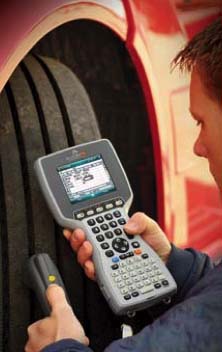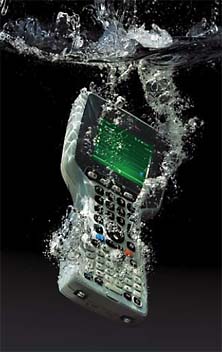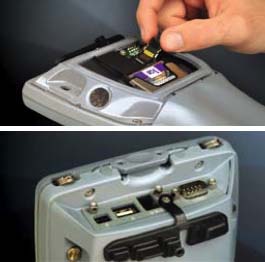The Allegro MX from Juniper Systems, introduced in the summer of 2008, is a technology upgrade to the company's Allegro CX, an ultra-rugged, no-nonsense handheld computer for use in a variety of demanding field applications. It is a flexible tool for outdoor data collection job jobs, and Juniper Systems and their partners offer a broad lineup of dedicated software for it.
 The Allegro uses the traditional "flashlight-style" form factor to provide a tough handheld terminal that is very functional and ergonomically designed with a balanced weight distribution so it is easy to carry and operate.
The Allegro uses the traditional "flashlight-style" form factor to provide a tough handheld terminal that is very functional and ergonomically designed with a balanced weight distribution so it is easy to carry and operate.
The Allegro can either be used via touch or stylus, or via its extensive 62-key keypad that offers all the familiar functionality of a standard keyboard. A total of no fewer than 12 function keys can be hard-coded or programmed as softkeys. The keys provide tactile feedback and the keyboard bezel is removable for cleaning without affecting the seal.
The Allegro MX has a landscape-oriented transflective 240 x 320 pixel LCD that measures 3.8 inches diagonally. It has an adjustable LED backlight and works even in ultra-low temperatures without a heater. For applications where size and contrast matter most, Juniper offers a version with a slightly larger 4.1-inch monochrome display with a paper-like white background. The monochrome version includes a display heater.
 On the technology front, the Allegro MX has received several upgrades compared to the still available Allegro CX. Instead of using the time-proven 400MHz version of Marvell's PXA255 application processor to run Windows CE.Net 4.2, the new MX is powered by the 624MHz version of the Marvell PXA270 chip and it runs Windows Mobile 6.1 Classic (the very latest version available as of this writing). The device still comes with 128MB of RAM, but the amount of non-volatile storage has been increased. It's now up to a gigabyte in the monochrome version and up to two GB in the color version. This means your data is always safe, even if you run out of battery power.
On the technology front, the Allegro MX has received several upgrades compared to the still available Allegro CX. Instead of using the time-proven 400MHz version of Marvell's PXA255 application processor to run Windows CE.Net 4.2, the new MX is powered by the 624MHz version of the Marvell PXA270 chip and it runs Windows Mobile 6.1 Classic (the very latest version available as of this writing). The device still comes with 128MB of RAM, but the amount of non-volatile storage has been increased. It's now up to a gigabyte in the monochrome version and up to two GB in the color version. This means your data is always safe, even if you run out of battery power.
The MX has a standard user-accessible PC Card slot can be used to add storage or a variety of wireless or other functions. A MicroSD/SDHC slot has been added as a much welcome update. Bluetooth Class 2 is now standard as opposed to being only available as an integrated module as was the case with the Allegro CX. The port configuration has changed a bit as well. Instead of two serial ports you now get one serial port and full-size USB host connector, and that's in addition to the USB client port that was already available before. Infrared is gone; Bluetooth has pretty much replaced it as a short distance means of wireless communication.
Since it will primarily be used outdoors, the Allegro is extremely durable. It is sealed to IP67 specifications, which means it is dust-proof and won't get damaged even in driving rain or if it falls into a puddle of water. An extremely wide operating range from -22 to 130 degrees Fahrenheit means it can be used practically anywhere.
 The Allegro MX is powered by a powerful NiMH battery that lasts 10 to 20 hours depending on what application is run. That is almost as much as the older and less powerful CX version. An optional alkaline battery holder is available.
The Allegro MX is powered by a powerful NiMH battery that lasts 10 to 20 hours depending on what application is run. That is almost as much as the older and less powerful CX version. An optional alkaline battery holder is available.
Juniper Systems offers a variety of expansion pods for the Allegro. The pods are fully sealed and can add bar code scanning, RFID, WiFi and Trimble Lassen LP GPS. There are also special data acquisition pods for use with National Instrument's PCMCIA and PCMCIA-4050 cards.





